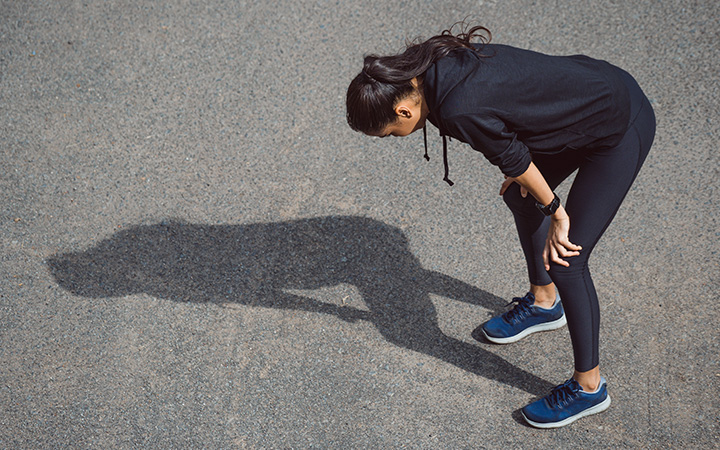Top 4 Tips For Exercising In the Heat
July 12, 2021

Everyone who has exercised in hot, humid conditions knows it feels harder to perform. The decreased tolerance is because hot, humid environments strains your body's ability to regulate its temperature thermoregulatory and functions, which decreases your exercise capacity and increase your risk of dehydration and heat stress.
It is essential to recognize the need to adjust your intensity of exercise as the temperature and humidity rises. Besides affecting performance, exercising in the heat increases the risk of serious illnesses such as heat illness, heat exhaustion, or heat stroke.
How Your Body Handles Heat
Heat regulation is a balance of heat transfer between our body and the environment to maintain your core temperature “set-point” of about 98.6 degrees. As you exercise, your core temperature rises and transfers heat to your skeletal muscles until the muscles are warmed up. Then the heat begins to transfer back to your core until your core temperature rises and needs to be transferred to your skin and out to the environment.
The body loses heat by radiation -- in which heat moves away from the body -- and convection -- in which heat is shed through air moving over your skin. Radiation and convection transfer heat to the environment until the thermometer reaches 96.8 degrees -- then your body's heat is absorbed rather than dissipated. At that point, your body mostly cools itself by evaporation, or sweat. Sweating relies on water evaporating, which requires air flow and water vapor pressure gradient, or condensation, between the skin and air. Sweating is more effective in low humidity or dry air.
Hydration is closely tied to heat-exercise tolerance. The core temperature threshold (or set-point) is closely tied to fluid volume and concentration. Dehydration means your body’s fluid concentration is high and fluid volume is low, indicating that your body needs to hold onto fluid (and not sweat). The decreased sweat rate leads to decreased heat loss, which increases the core temperature. Dehydration also causes decreased cardiac performance and decreased exercise tolerance in hot weather.
Here are my top four tips for exercising when temperatures soar:
1. Get Used To Exercising in Hot Weather
Acclimate yourself over a period of about one to two weeks - longer is better.
- Repeated bouts of exercise-heat exposure increase body’s sweat and blood flow responses, increase plasma volume and improve cardiovascular stability and fluid-electrolyte balance.
- Extent of adaptation depends on intensity, duration, frequency and number of heat exposures.
- If you are training for a race, try to mimic the race environment (for example, temperature, humidity and altitude) for best acclimation. If not possible, use an artificially hot indoor environment.
- Effects may last two to four weeks, but this has not been well-studied
2. Maintain Hydration
- Start exercise hydrated. Drink 0.03 ounces of fluid per 2 pounds of body weight every two to three hours before exercise. For example, an athlete who weighs 150 pounds should drink about 15 ounces every three hours before exercising.
- A visual reference for hydration is the color of your urine. It should be a pale yellow to clear.
- Maintain hydration to avoid more than 2 percent loss of body weight
- For exercise longer than an hour, supplement with fluid that includes salt concentration of 0.5 to 0.7 grams of salt per liter of fluid for normal sweaters and 45 mg salt to one ounce of fluid for those who sweat heavily or get cramps.
3. Take in Carbohydrates
- Aim for 30 to 60 grams per hour of carbohydrates. Exercise of more than 2.5 hours requires up to 90 grams per hour of carbs through food and fluids. More than that may not have greater effects.
- Combine liquid and solid carb sources, and drink water to aid with ingesting solid foods.
- Avoid drinks with more than 10 percent carbs -- aim for 4 percent to 8 percent and check your tolerance before your event, as higher carbohydrate concentrations may upset your stomach.
- Look at the carbohydrate amount on the label and divide by amount of fluid to see the concentration. For example: 15 grams of carbs per serving divided by 240 milliliters (or one fluid cup) equals .625 x 100 or a 6 percent drink.
- Other sources of carbs -- banana (30 grams); one tablespoon of honey (28 grams); sports gummy (about 25 grams); sports bar (about 45 grams)
- Carbohydrates should be in a mixture of sugar types to avoid digestion difficulty. Glucose and fructose are easily absorbed and sucrose, a combination of glucose and fructose, allows larger amounts as they are absorbed on different pathways.
4. Plan for Recovery
- Assure rehydration with sodium, fluid, and protein after prolonged exercise.
- Carbohydrates should be consumed within 60 minutes of exercise to assist with muscle glycogen resynthesis (ie energy stores).
- Make sure you are rehydrated and fueled before another exercise challenge.
- Ice bath or cold water submersion is the fastest and best way to treat heat illness. If you have concerns about heat illness, cool yourself immediately but only with supervision.
Sources:
Consensus Recommendations on Training and Competing in the Heat. S Racinais et al. Sports Med (2015) 45;925-938
Thermoregulation during exercise in the heat. Strategies for maintaining health and performance. D Wendt et al. Sports Med 2007; 37 (8): 669-682
Laura Goldberg, MD, specializes in pediatric sports medicine and is Medical Director of UH West Side Sports Medicine.
Related Links
University Hospitals Sports Medicine takes a multidisciplinary approach that integrates care from medical experts who specialize in the diagnosis and treatment for athletes of all ages and abilities. Our fellowship-trained sports medicine specialists, primary care doctors, nutritionists, sleep experts and other healthcare professionals ensure the very best in health and medical care for athletes. Learn more about sports medicine and find a physician for you.
Tags: Athletes, Exercise, Sports, Laura Goldberg, MD


